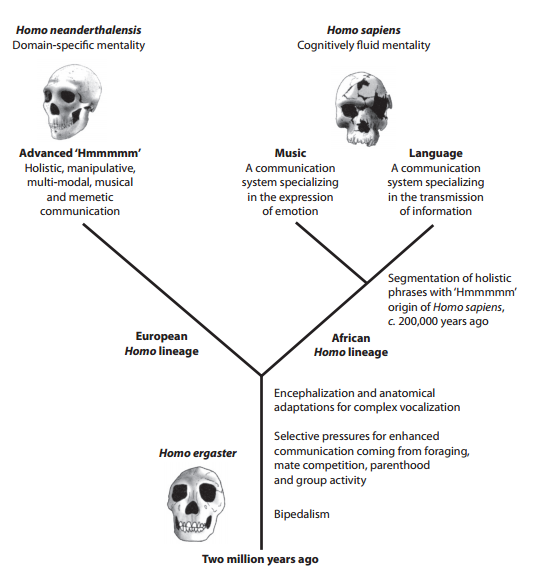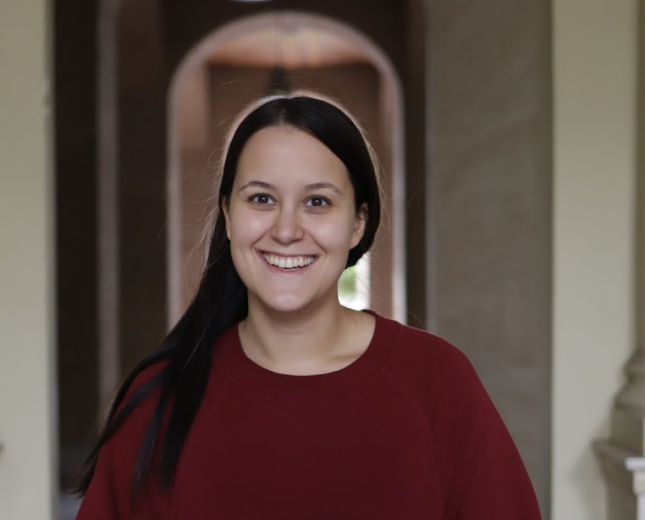Talking about the origins of music and language
The curiously named book The Singing Neanderthals by Stephen Mithen is the book I wish I’d written and still hold hopes that one day I might. Its basic premise is that music and language developed at around the same time and that music is a fundamental part of us, not merely a byproduct. It’s a thought that surely resonates with all music enthusiasts.
Mithen suggests a hmmmmm evolutionary theory of language and music, a word that stands for holistic, manipulative, multi-modal, musical, and mimetic. He claims that such was the type of communication used by ancestors of Homo sapiens in Africa. He includes the following figure in his book, perfectly explaining when and how music and language evolved:

The evolution of music and language (S. Mithen. 2005. The Singing Neanderthals. Page 267.)
Interesting facts
Lesion studies (studies of patients who have deficits as a result of brain damage) show that music and language capacities can be entirely or partially dissociated. In layman’s terms, this is seen through patients who suffered brain damage and lost the ability to speak, but retain the ability to sing, and vice-versa. However, brain-imaging studies suggest that language and music do in fact share the same neural networks. For now, this remains a mysterious contradiction (*note: the book was written nearly 10 years ago, so I need to further verify that this in fact still holds)
When speaking to infants (so-called IDS or infant-directed speech), speakers of very different languages (European languages on the one hand and Xhosa, Chinese and Japanese on the other) produce the same patterns of heightened pitch and expanded pitch range. This is curious because logic dictates that tonal languages (like Chinese), where word meaning changes with the change in pitch, would differ in this from stress languages (like English), where a change in pitch does not alter meaning, only influences the importance of the word in a sentence.
IDS (infant-directed speech) and PDS (pet-directed speech) have quite a few uncomfortable similarities. Whereas we know IDS is used to help infants learn speech, why would we talk with a heightened pitch to our dog, for whom we presumably know that it will never learn to speak?
Associations between sound and size might just be universal. Sound synaesthesia (neurally mapping the variable of size onto the variable of sound) would mean that we connect certain sounds with small sizes and others with bigger sizes. In the 1920s, Sapir sought to prove this by choosing two nonsense words, mil and mal, and asked experiment participants which word meant the smaller table and which one the bigger one. Almost all participants, although from various cultures, chose mal to denote the bigger table.
Darwin was amongst the first to suggest that the revolutionary role of human music was to serve as courtship display. So we have music thanks to sexual selection, and it was suggested that the better the neanderthal could sing, the more genes they passed forward. There have been some attempts to prove this theory, for example Miller who examined the age and sex of music-makers, and found that males produced ten times more music than females and were most productive at around the age of thirty (peak mating effort). Of course it is unclear how much sexist Western bias there was in his results.
The oldest flute was found in Slovenia. Well, it is unclear whether the flute is actually a flute and as such proves that neanderthals made music 50,000 years ago. It might have just been an old bone gnawed on by a carnivore. But I am Slovenian so I can revel in my wishful thinking that we might have been ancient musicians.
There might be a language gene! How exciting is that?!? This discovery was based on the case study of a family who had particular language problems and were found to have the malfunctioning gene. Unfortunately, FOXP2 is not the gene for grammar or language, it might just be one of several, but it does pose compelling evidence that there is in fact a genetic basis to human language.
Formulaic phrases in language are what helps us speak. They are multiword units saved in our brains for quick retrieval. They are the phrases we remember and can use at any time, seemingly without even thinking about it (think about phrases such as “how do you do” or “bless you” or even “I’m sorry”).
Disclaimer: These are book thoughts on The Singing Neanderthals (2005) by Steven Mithen. The content is the author’s intellectual property.
Note: This article was first published on a previous, free, version of my blog called scienceofmusic and has since been deleted.

